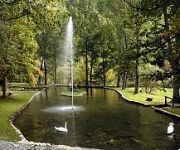Facts and Data
Webpages:
Official Unesco Page
La Vall de Boí (spanish only)
La Vall de Boí, Patrimoni de la Humanitat (only in Spanish)
Basis Data:
Unesco World heritage since: 2000
Size of heritage: 7.98 ha
- Buffer zone: 3,562 ha
Coordinates:
Longitude: 0,804°
Latitude: 42,505°
Summary
The narrow Vall de Boí is situated in the high Pyrénées, in the Alta Ribagorça region and is surrounded by steep mountains. Each village in the valley contains a Romanesque church, and is surrounded by a pattern of enclosed fields. There are extensive seasonally-used grazing lands on the higher slopes.
Location on Map
Show bigger map on Openstreetmap
Introduction
The Catalan Romanesque Churches of the Vall de Boí, located in the Province of Lleida, Autonomous Community of Catalonia, Spain, are a remarkable UNESCO World Heritage site. This collection of nine churches showcases the exceptional Romanesque architectural style and provides a glimpse into the rich cultural and religious history of the region.History
The Vall de Boí, nestled in the Pyrenees Mountains, was an important religious and cultural center during the Middle Ages. The construction of these churches began in the 11th century and continued into the 12th century. They were built as a testament to the religious devotion of the local population and to establish the presence of Christianity in the region.Architectural Features
The Catalan Romanesque Churches of the Vall de Boí exhibit distinctive architectural features that make them truly exceptional. The churches are characterized by their compact size, simple geometric shapes, and robust stone construction. The use of local materials, such as slate and granite, adds to their unique charm. The facades are adorned with intricate carvings and sculptures, depicting biblical scenes and religious figures.Current State
Today, the Catalan Romanesque Churches of the Vall de Boí are meticulously preserved and open to visitors. The churches are still active places of worship, hosting religious ceremonies and events. The local community takes great pride in their cultural heritage and actively participates in the maintenance and conservation of these architectural gems.Notable Churches
Among the nine churches, some stand out for their historical and architectural significance. The Church of Sant Climent de Taüll is particularly renowned for its stunning frescoes, which depict scenes from the Bible and the Last Judgment. The Church of Santa Maria de Taüll is another notable site, featuring a beautiful bell tower and a remarkable collection of Romanesque paintings.Importance and Recognition
The Catalan Romanesque Churches of the Vall de Boí were inscribed as a UNESCO World Heritage site in 2000. This recognition highlights their outstanding universal value and the need for their preservation. The churches serve as a testament to the artistic and cultural achievements of the Romanesque period in Catalonia and provide valuable insights into the religious practices of the time.Tourism and Cultural Significance
The Vall de Boí and its Romanesque churches attract numerous tourists and art enthusiasts from around the world. Visitors can explore the churches, admire the intricate details of the architecture, and immerse themselves in the spiritual ambiance of these sacred spaces. The site also offers guided tours and educational programs, allowing visitors to delve deeper into the history and significance of the churches.Conclusion
The Catalan Romanesque Churches of the Vall de Boí are a treasure trove of architectural and cultural heritage. Their historical significance, exceptional architectural features, and religious importance make them a must-visit destination for anyone interested in exploring the rich history of Catalonia and the Romanesque period. The preservation and appreciation of these churches ensure that their legacy will continue to inspire and educate future generations.Hotels and places to stay
Manantial Balneari C. de Boí
Time Information
Videos from the area
Videos provided by Youtube are under the copyright of their owners.







